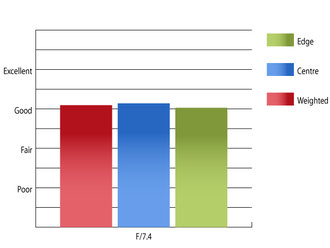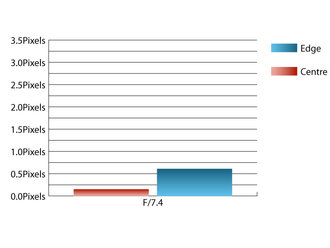Dorr 12mm f/7.4 Fisheye Wide-Angle Lens Review
Dorr 12mm f/7.4 Fisheye Wide-Angle Performance
Images taken with this lens often display strange colour casts and have a 'toy lens' look to them. Even so, it is capable of good sharpness across the frame. Unfortunately, getting this performance with any consistency can be difficult, which I suppose is all part of the fun? It could be that the sample provided has an issue with the focusing mechanism, so we may have to test another sample when we can to investigate that.  MTF @ 12mm | How to read our chartsThe blue column represents readings from the centre of the picture frame at the various apertures and the green is from the edges. Averaging them out gives the red weighted column.The scale on the left side is an indication of actual image resolution. The taller the column, the better the lens performance. Simple. For this review, the lens was tested on a Sony NEX-7 using Imatest. |
Surprisingly, for a fisheye, chromatic aberrations are well controlled, with fringing only just exceeding half a pixel width towards the edges of the frame.
 CA @ 12mm | How to read our chartsChromatic aberration is the lens' inability to focus on the sensor or film all colours of visible light at the same point. Severe chromatic aberration gives a noticeable fringing or a halo effect around sharp edges within the picture. It can be cured in software.Apochromatic lenses have special lens elements (aspheric, extra-low dispersion etc) to minimize the problem, hence they usually cost more. For this review, the lens was tested on a Sony NEX-7 using Imatest. |
Even with the fixed f/7.4 aperture, falloff of illumination towards the corners can be seen under certain conditions. Imatest read the corners as 1.47 stops darker than the image centre. As the aperture is not adjustable, there is no way to achieve visually uniform illumination.
Distortion is high as you might expect from a fisheye. Using a fisheye lens will always be a creative choice, where the distortion is used to enhance your image.
During testing, this lens proved itself very prone to flare, and contrast is noticeably reduced when shooting into the light. If treated right, this effect can be used to your advantage, creating a 'toy lens' look in images, without the use of Instagram, filters, or any other digital trickery.
Add your message
Login required
Please login here or if you've not registered, you can register here. Registering is safe, quick and free.
Please login here or if you've not registered, you can register here. Registering is safe, quick and free.
photodo Stats
1102 lenses
428 MTF tests
74 in-depth photodo reviews
100+ users join each day
Help the lens community by reviewing or rating a lens today via our lens search
428 MTF tests
74 in-depth photodo reviews
100+ users join each day
Help the lens community by reviewing or rating a lens today via our lens search
Latest Lens Reviews
- Chinon 28mm f/2.8 Vintage Lens Review
- Canon EF 70-200mm f/4L IS II USM Lens Review
- Samyang AF 85mm f/1.4 EF Review
- Sigma 70mm f/2.8 DG Macro Art Review
- Samyang AF 24mm f/2.8 FE Review
- Meike 50mm f/1.7 Review
- Tamron 70-210mm f/4 Di VC USD Review
- Lensbaby Burnside 35mm f/2.8 Review
- Asahi Super Takumar 50mm f/1.4 Review
- Asahi Super-Multi-Coated Takumar 135mm f/3.5 Review
